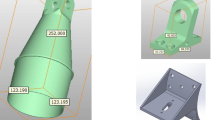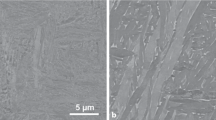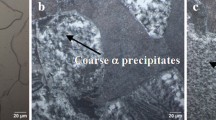Abstract
Extra low interstitial (ELI) grade of titanium alloy Ti6Al4V is used for the fabrication of components operating at cryogenic temperatures in satellite launch vehicles, given its excellent combination of strength and toughness up to 90 K. In the present study, test coupons required for strength and toughness evaluation were 3D printed in X, Y, Z, and 45°(along the direction of a body diagonal of an imaginary cubic build volume) orientations through laser powder bed fusion (LPBF) process and were vacuum stress relieved. Mechanical properties at room temperature met the minimum specified values against ASTM-F3001 standard in all orientations and were consistent within each orientation. However, the highest strength (~ 1080 MPa) and toughness were observed in the 45° orientation. The impact strength was in the range of 333–363 kJ/m2, and plane strain fracture toughness (KIc) values in X, Y, and 45° orientations were > 60 MPa√m. In the Z orientation, a marginally lower KIc value (58 MPa√m) was observed and is attributed to the higher probability of easier propagation of cracks in between the 3D printed layers. Microstructure in all the four orientations revealed a mixture of fine alpha (α) laths and acicular alpha prime (α′) in the transformed beta (β) matrix. Higher strength in the samples representative of Z and 45° orientations is attributed to higher dislocation density and higher grain boundary length. Higher fracture toughness observed in specimen representative of 45° orientation is attributed to the higher grain orientation spread (GOS) and lower volume fraction of pores, which results in a more tortuous crack propagation path. Fractography in all orientations showed typical ductile failure with the presence of dimples. Finally, based on the strength and toughness in different orientations, it can be concluded that LPBF processed Ti6Al4V-ELI components can be used in stress relieved condition for fracture critical aerospace applications at room temperature.













Similar content being viewed by others
Availability of data and material
The data are a part of continuing research and hence cannot be shared at this point in time.
Code availability
There is no code used in this activity.
References
Tamirisakandala S, Vedam BV, Bhat RB (2003) Recent advances in the deformation processing of titanium alloys. J Mater Eng Perform 12:661–673. https://doi.org/10.1361/105994903322692466
Anil Kumar V, Gupta RK, Prasad MJNV, Narayana Murty SVS (2021) Recent advances in processing of titanium alloys and titanium aluminides for space applications: a review. J Mater Res 36:689–716. https://doi.org/10.1557/s43578-021-00104-w
Liu S, Shin YC (2019) Additive manufacturing of Ti6Al4V alloy: a review. Mater Des 164:107552. https://doi.org/10.1016/j.matdes.2018.107552
Huang R, Riddle M, Graziano D et al (2016) Energy and emissions saving potential of additive manufacturing: the case of lightweight aircraft components. J Clean Prod 135:1559–1570. https://doi.org/10.1016/j.jclepro.2015.04.109
Gibson I, Rosen D, Stucker B (2015) Additive manufacturing technologies. Springer, New York
Agius D, Kourousis K, Wallbrink C (2018) A review of the as-built SLM Ti–6Al–4V mechanical properties towards achieving fatigue resistant designs. Metals (Basel) 8:75. https://doi.org/10.3390/met8010075
Seifi M, Salem A, Beuth J et al (2016) Overview of materials qualification needs for metal additive manufacturing. JOM 68:747–764. https://doi.org/10.1007/s11837-015-1810-0
Gorsse S, Hutchinson C, Gouné M, Banerjee R (2017) Additive manufacturing of metals: a brief review of the characteristic microstructures and properties of steels, Ti–6Al–4V and high-entropy alloys. Sci Technol Adv Mater 18:584–610. https://doi.org/10.1080/14686996.2017.1361305
Galarraga H, Warren RJ, Lados DA et al (2017) Effects of heat treatments on microstructure and properties of Ti–6Al–4V ELI alloy fabricated by electron beam melting (EBM). Mater Sci Eng A 685:417–428. https://doi.org/10.1016/j.msea.2017.01.019
Cui C, Hu B, Zhao L, Liu S (2011) Titanium alloy production technology, market prospects and industry development. Mater Des 32:1684–1691. https://doi.org/10.1016/j.matdes.2010.09.011
Uhlmann E, Kersting R, Klein TB et al (2015) Additive manufacturing of titanium alloy for aircraft components. Procedia CIRP 35:55–60. https://doi.org/10.1016/j.procir.2015.08.061
Herzog D, Seyda V, Wycisk E, Emmelmann C (2016) Additive manufacturing of metals. Acta Mater 117:371–392. https://doi.org/10.1016/j.actamat.2016.07.019
Yusuf SM, Gao N (2017) Influence of energy density on metallurgy and properties in metal additive manufacturing. Mater Sci Technol 33:1269–1289. https://doi.org/10.1080/02670836.2017.1289444
Wang M, Lin X, Huang W (2016) Laser additive manufacture of titanium alloys. Mater Technol. https://doi.org/10.1179/1753555715Y.0000000079
Frazier WE (2014) Metal additive manufacturing: a review. J Mater Eng Perform 23:1917–1928. https://doi.org/10.1007/s11665-014-0958-z
Kannan GB, Rajendran DK (2017) A review on status of research in metal additive manufacturing. In: Ian Wimpenny D, Pandey PM, Jyothish Kumar L (ed) Advances in 3D printing and additive manufacturing technologies. Springer, Singapore, pp 95–100
Yang Z, Xu Y, Sisson RD, Liang J (2020) Factors influencing the corrosion behavior of direct metal laser sintered Ti–6Al–4V for biomedical applications. J Mater Eng Perform 29:3831–3839. https://doi.org/10.1007/s11665-020-04904-9
Traini T, Mangano C, Sammons RL et al (2008) Direct laser metal sintering as a new approach to fabrication of an isoelastic functionally graded material for manufacture of porous titanium dental implants. Dent Mater 24:1525–1533. https://doi.org/10.1016/j.dental.2008.03.029
Dutta B, Froes FH (2017) The additive manufacturing (AM) of titanium alloys. Met Powder Rep 72:96–106. https://doi.org/10.1016/j.mprp.2016.12.062
Castells R DMLS vs SLM 3D Printing for Metal Manufacturing. https://www.element.com/nucleus/2016/dmls-vs-slm-3d-printing-for-metal-manufacturing
AMS4930L (2020) Titanium alloy bars, wire, forgings, and rings 6Al–4V, extra low interstitial annealed. SAE Int https://doi.org/10.4271/AMS4930K
Specification for Titanium Alloy Ti6Al4V ELI Forgings, Rods, Rings and Blocks (Annealed), VSSC: MMPS: 3103F:2011
Vrancken B, Thijs L, Kruth J-P, Van Humbeeck J (2012) Heat treatment of Ti6Al4V produced by selective laser melting: microstructure and mechanical properties. J Alloys Compd 541:177–185. https://doi.org/10.1016/j.jallcom.2012.07.022
Moletsane MG, Krakhmalev P, Kazantseva N et al (2016) Tensile properties and microstructure of direct metal laser-sintered Ti6Al4V (ELI) alloy. South Afr J Ind Eng. https://doi.org/10.7166/27-3-1667
Yadroitsev I, Krakhmalev P, Yadroitsava I, Du Plessis A (2018) Qualification of Ti6Al4V ELI alloy produced by laser powder bed fusion for biomedical applications. JOM 70:372–377. https://doi.org/10.1007/s11837-017-2655-5
van Zyl I, Moletsane M, Krakhmalev P et al (2016) Validation of miniaturised tensile testing on DMLS Ti6Al4V (ELI) Specimens. S Afr J Ind Eng. https://doi.org/10.7166/27-3-1666
Muiruri AM, Maringa M, du Preez W, Masu L (2018) Variation of impact toughness of as-built dmls Ti6Al4V (ELI) specimens with temperature. S Afr J Ind Eng. https://doi.org/10.7166/29-3-2076
Muiruri A, Maringa M, du Preez W, Masu L (2020) Effects of stress-relieving heat treatment on impact toughness of direct metal laser sintering (DMLS)-produced Ti6Al4V (ELI) parts. JOM 72:1175–1185. https://doi.org/10.1007/s11837-019-03862-5
Galarraga H, Lados DA, Dehoff RR et al (2016) Effects of the microstructure and porosity on properties of Ti–6Al–4V ELI alloy fabricated by electron beam melting (EBM). Addit Manuf 10:47–57. https://doi.org/10.1016/j.addma.2016.02.003
(2016) EOS Titanium Ti64ELI, Material data sheet
ASTM-F3001 (2014) Standard Specification for Additive Manufacturing Titanium-6 Aluminum-4 Vanadium ELI (Extra Low Interstitial) with Powder Bed Fusion. In: ASTM book of Standards
Monaheng LF, du Preez WB, Polese C (2021) Towards qualification in the aviation industry: impact toughness of Ti6Al4V(ELI) specimens produced through laser powder bed fusion followed by two-stage heat treatment. Metals (Basel) 11:1736. https://doi.org/10.3390/met11111736
E94/E94M (2017) Designation: E94/E94M-17 Standard Guide for Radiographic Examination Using Industrial Radiographic Film 1. In: ASTM Book of Standards, pp 1–13
ASTM-E8 (2018) Standard test methods for tension testing of metallic materials. In: ASTM book of standards
ASTM-E23 (2018) Standard test methods for notched bar impact testing of metallic materials. In: ASTM book of standards
ASTM-E399 (2020) Standard test method for linear-elastic plane-strain fracture toughness of metallic materials. In: ASTM book of standards
E3 (2017) E 3-11 preparation of metallographic specimens. In: ASTM Book of standards, pp 1–12
E112 (2013) E112-13 Standard test methods for determining average grain size. In: ASTM book of standards, pp 1–28
Yan Q, Chen B, Kang N et al (2020) Comparison study on microstructure and mechanical properties of Ti–6Al–4V alloys fabricated by powder-based selective-laser-melting and sintering methods. Mater Charac 164:110358. https://doi.org/10.1016/j.matchar.2020.110358
Xu W, Sun S, Elambasseril J et al (2015) Ti–6Al–4V additively manufactured by selective laser melting with superior mechanical properties. JOM 67:668–673. https://doi.org/10.1007/s11837-015-1297-8
Xu W, Brandt M, Sun S et al (2015) Additive manufacturing of strong and ductile Ti–6Al–4V by selective laser melting via in situ martensite decomposition. Acta Mater 85:74–84. https://doi.org/10.1016/j.actamat.2014.11.028
Wu B, Pan Z, Ding D et al (2018) Effects of heat accumulation on microstructure and mechanical properties of Ti6Al4V alloy deposited by wire arc additive manufacturing. Addit Manuf 23:151–160. https://doi.org/10.1016/j.addma.2018.08.004
Cain V, Thijs L, Van Humbeeck J et al (2015) Crack propagation and fracture toughness of Ti6Al4V alloy produced by selective laser melting. Addit Manuf 5:68–76. https://doi.org/10.1016/j.addma.2014.12.006
Gupta A, Bennett CJ, Sun W (2021) The role of defects and characterisation of tensile behaviour of EBM Additive manufactured Ti–6Al–4V: an experimental study at elevated temperature. Eng Fail Anal 120:105115. https://doi.org/10.1016/j.engfailanal.2020.105115
Phutela C, Aboulkhair NT, Tuck CJ, Ashcroft I (2020) The effects of feature sizes in selectively laser melted Ti–6Al–4V parts on the validity of optimised process parameters. Materials (Basel) 13:117. https://doi.org/10.3390/ma13010117
Antonysamy AA (2012) Microstructure, texture and mechanical property evolution during additive manufacturing of Ti6Al4V alloy for aerospace applications. The University of Manchester, London
Vilardell AM, Fredriksson G, Yadroitsev I, Krakhmalev P (2019) Fracture mechanisms in the as-built and stress-relieved laser powder bed fusion Ti6Al4V ELI alloy. Opt Laser Technol 109:608–615. https://doi.org/10.1016/j.optlastec.2018.08.042
ASM, Aerospace Specification Metals Inc. http://asm.matweb.com/search/SpecificMaterial.asp?bassnum=MTP643. 26 May, 2021
Lizzul L, Sorgato M, Bertolini R et al (2021) Anisotropy effect of additively manufactured Ti6Al4V titanium alloy on surface quality after milling. Precis Eng 67:301–310. https://doi.org/10.1016/j.precisioneng.2020.10.003
Kok Y, Tan XP, Wang P et al (2018) Anisotropy and heterogeneity of microstructure and mechanical properties in metal additive manufacturing: a critical review. Mater Des 139:565–586. https://doi.org/10.1016/j.matdes.2017.11.021
Yadollahi A, Shamsaei N (2017) Additive manufacturing of fatigue resistant materials: Challenges and opportunities. Int J Fatigue 98:14–31. https://doi.org/10.1016/j.ijfatigue.2017.01.001
Yadollahi A, Shamsaei N, Thompson SM et al (2017) Effects of building orientation and heat treatment on fatigue behavior of selective laser melted 17–4 PH stainless steel. Int J Fatigue 94:218–235. https://doi.org/10.1016/j.ijfatigue.2016.03.014
Edwards P, O’Conner A, Ramulu M (2013) Electron beam additive manufacturing of titanium components: properties and performance. J Manuf Sci Eng. https://doi.org/10.1115/1.4025773
Prasad K, Obana M, Ito A, Torizuka S (2021) Synchrotron diffraction characterization of dislocation density in additively manufactured IN 718 superalloy. Mater Charact 179:111379. https://doi.org/10.1016/j.matchar.2021.111379
Prasad K, Horita Y, Ito A, Torizuka S (2021) In situ synchrotron diffraction study of a crack-free additively manufactured Ni base superalloy. Scr Mater 200:113896. https://doi.org/10.1016/j.scriptamat.2021.113896
Narayana Murty SVS, Torizuka S, Nagai K et al (2008) Effects of strain on grain boundary characteristics and their correlation to mechanical properties in low carbon steel processed by warm multipass calibre rolling. Mater Sci Technol 24:1167–1173. https://doi.org/10.1179/174328407X213233
Van Hooreweder B, Moens D, Boonen R et al (2012) Analysis of fracture toughness and crack propagation of Ti6Al4V produced by selective laser melting. Adv Eng Mater 14:92–97. https://doi.org/10.1002/adem.201100233
Acknowledgements
The authors thank the support provided by the National Facility for Texture and Oriental Imaging Microscopy (OIM), Indian Institute of Technology Bombay (IITB), Bombay, for the EBSD analysis. The authors are thankful to Deputy Director, Materials and Mechanical Entity (MME), for the encouragement provided during this work. They also thank Director, Vikram Sarabhai Space Center (VSSC), for granting permission for publishing this work.
Funding
This work did not receive any funding from any external funding agency.
Author information
Authors and Affiliations
Corresponding author
Ethics declarations
Conflicts of interest
The authors do not have any conflict/competing interests with anyone/any groups.
Additional information
Handling Editor: M. Grant Norton.
Publisher's Note
Springer Nature remains neutral with regard to jurisdictional claims in published maps and institutional affiliations.
Rights and permissions
About this article
Cite this article
Manikandan, P., Kumar, V.A., Pradeep, P.I. et al. On the anisotropy in room-temperature mechanical properties of laser powder bed fusion processed Ti6Al4V-ELI alloy for aerospace applications. J Mater Sci 57, 9599–9618 (2022). https://doi.org/10.1007/s10853-022-07032-y
Received:
Accepted:
Published:
Issue Date:
DOI: https://doi.org/10.1007/s10853-022-07032-y




